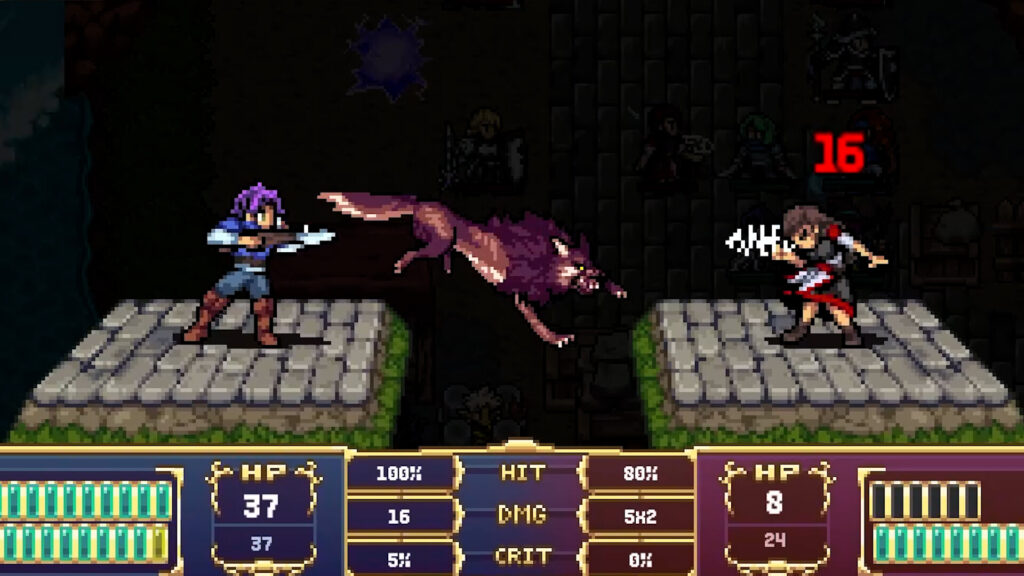🧭 A War-Torn World with Real Stakes
Dark Deity 2 picks up 25 years after the events of the first game, and Verroa—now fragile and fractured—is once again under threat. The Holy Asverellian Empire has expansion on its mind, and it’s your job to stop them. You command the Eternal Delegation, a ragtag group of descendants and newcomers led by Gwyn and Riordian, trying to hold the kingdom together while fighting on all fronts.
Right off the bat, the story has more political teeth than its predecessor. You’re not just fighting monsters and evil mages—you’re threading alliances, playing power games, and watching your every choice shift the balance of power. Whether you side with a broken noble house or abandon them to keep your army intact, your decisions have weight. Sometimes brutal, often morally gray, and always tactically significant.

🛡️ Turn-Based Combat That Cuts Deep
Combat in Dark Deity 2 is meatier than ever. You’re commanding 20 unique characters across a branching network of 45 classes. This isn’t Fire Emblem lite. It’s a game where positioning, ability synergy, class matchups, and even emotional bonds between characters all factor into the win or loss.
Each unit starts strong but evolves dramatically. Want to turn your cautious healer into a battle cleric who buffs and bashes? You can. Want to morph your archer into a teleporting, crossbow-wielding menace? Go ahead. The class trees allow serious flexibility, and gear plays a huge role too. Equipping the right passive traits and special weapons can break an entire encounter wide open.
The difficulty curve doesn’t hold your hand. If you’re careless, you’ll lose a key unit, and no, they won’t come back—unless you’re playing on a custom setting that removes permadeath. Even normal mode demands forethought and forces you to use terrain, flanking, and team combos to stay alive.
🔀 Replayability is Built In
This game doesn’t just encourage multiple playthroughs—it’s built for them. Dark Deity 2 includes an official randomizer and full campaign customization tools. Want a run where your healer is a frontline tank with double the usual strength? Done. Want randomized recruitment, altered XP rates, or permadeath toggled? You’ve got it.
This makes the game more than just replayable—it’s practically a new tactical sandbox every time. Between branching paths, relationship changes, shifting political alliances, and wildly different class builds, no two campaigns will be the same.
And with 20 characters to rotate and experiment with, it’s not just about who survives—it’s about who becomes irreplaceable.
🎨 Pixel Art With Soul, But No Voices to Match
Visually, the game lands right where it needs to. The pixel art is crisp, expressive, and packed with detail. Battle animations are sharp, and character portraits carry a lot of emotional weight, even without voice acting.
But yes, that lack of voice work is felt. In key scenes—where your characters are making massive decisions or dealing with gut-wrenching betrayals—having only text to carry the emotion feels like a missed opportunity. It’s not a dealbreaker, but it’s noticeable.
That said, the soundtrack steps up. Emotional, epic, and ambient where it needs to be, the music fills the void and sells the scale of the conflict, even when voices don’t.
🧠 The Good Stuff
- Strategic Depth: With 45 branching classes and near-infinite unit combinations, every map becomes a mental puzzle.
- Moral Choices That Matter: You’re not just picking between red and blue options. Your choices shift how the story plays out and who fights beside you.
- Replay Value: Thanks to the randomizer and modifiers, this is one of the most replayable TRPGs in recent memory.
- Customization Overload: Stats, gear, skills, relationships—if you want control, this game hands it to you with both fists.
- Visual Identity: From the UI to the sprite work, it looks like a game made by people who love the genre.
🧨 What Holds It Back
- High Barrier to Entry: If you’re new to TRPGs, this game expects you to swim in the deep end right away.
- Midgame Fatigue: Some battles, especially in the mid-game, feel like filler—lots of units, low narrative stakes.
- No Voice Acting: The story hits hard, but the absence of performances holds it back from emotional greatness.
- UI Jank: Equipment management, class transitions, and battlefield visibility can get clunky on longer sessions.
Dark Deity 2: Dark Deity 2 is not for the faint of heart. It expects you to learn, adapt, and think three turns ahead. But if you’re up for it, this game gives back tenfold. The tactical depth is phenomenal, the customization is unmatched, and the branching narrative paths make your choices matter. It’s not perfect. Some battles feel like padding. The story, while better than the original, still relies too much on text alone. But what’s here is gold for fans of Fire Emblem, Final Fantasy Tactics, or Triangle Strategy. If you want a tactical RPG that doesn’t hold your hand and rewards smart play, Dark Deity 2 is absolutely worth your time. – Flare